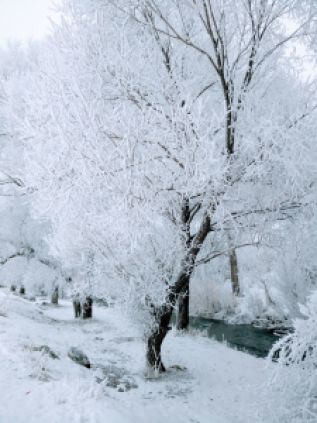This past weekend temperatures plunged to -15 degrees F (-25 degrees C). We turned our gas furnace up. Then we turned it up again. We got dressed and put our bathrobes back on. Our friends asked if we could reschedule the get-together we had planned for Sunday because of how cold it was and because they were having car problems. We agreed. For two days we simply didn’t go anywhere.
Monday morning our car wouldn’t start. I contacted my language teacher to cancel my lesson. Laura and I tried to push the car outside our gate and onto the street, but we couldn’t get the ol’ gal up the slight incline. We finally managed it when an older gentleman who was walking by and our neighbor appeared at about the same time and helped push. Right about then, a car drove up and stopped. The driver starting talking with our neighbor. Turned out they knew each other or something, and before we knew it, the man was pulling jumper cables out of his trunk. In less than a minute, our car was running. Handshakes all around. The guy with the jumper cables left. So did the older gentleman. The neighbor thought if we just let the car run 15 minutes or so, we’d be fine. He assured us we didn’t need a new battery.
We decided not to go into the city that afternoon like we had planned just in case the car decided not to start again. We called the person we were going to meet and cancelled. Then we began the process of thawing out our toes.

Yes, it was bone-chillingly cold. The car didn’t start. I had needed two pairs of gloves to keep my fingers from freezing and breaking into little pieces when we were pushing the car. Yes, my toes hurt because I had only one pair of socks on. But we were fine. Some stranger jump-started our car. The natural gas never stopped flowing to our furnace. Our water pipes never froze. The electricity never went out. All we had to do was hunker down and simply wait it out, which we did with no problem.
Then Laura started reading the Facebook posts of some of our friends and acquaintances that live closer to the city center. We figured their experience was like ours. An annoyance, yes. A great topic for extended small talk, yes. A big deal overall, no. I mean, if we, living on the outskirts of town, were surviving the cold, surely they were doing just as well if not better there in the big city. In fact, it’s not uncommon for me to sweat inside people’s apartments during the winter. Warmth is a high value here.
We were wrong.
The key to understanding what happened is to realize how heating works in most apartment buildings in the city. It’s all centralized heat. A huge factory heats water and sends it circulating through pipes that reach apartment complexes and connect to radiators located in each unit. Tenants have exactly zero control over the temperatures in their apartments. (Unless you count the ability to open a window as some type of control.)
They don’t decide when the hot water is turned on in the fall, they don’t decide when it’s turned off in the spring, and they don’t set the thermostat. That’s why I often sweat in people’s apartments during the winter. That’s why I wore T-shirts inside all winter long when we lived in our apartment and sometimes insisted that we open the windows to vent our little sauna.
Well, what happens when that single, enormous water heating factory fails? Yup, every last apartment connected to that central system begins to get cold. Then they begin to get really cold. Especially when it’s -15 degrees.
And how do people respond? They plug in their electric heaters. And blow the power grid in doing so. Some people went days without hot water circulating through their radiators, and during part of that time, some didn’t have electricity as a backup. Did I mention it was -15 degrees?
Of course, all eyes turned to the facility that heats the water. What happened? Last year the government took out a $386 million (million!) loan from China for the explicit purpose of renovating the facility. At the time, a big deal was made about how much better the heat factory was now that they had spent such mind-numbing amounts of money. Supposedly, the heat factory could now withstand whatever the weather might dish up. Supposedly.
And yet, what did journalists find just a few days ago upon visiting the facility? The rumor is that some parts of the place remain as they were during the Cuban Missile Crisis—except over 50 years older and all the worse for wear.
A local news report said that for that much money, they could have rebuilt the entire facility from the ground up.
So where’s the money? That is the $386 million question.
Meanwhile, the temperature has risen. Today we reached above freezing. Walking outside doesn’t feel like someone is poking your face with needles. The electricity is on. Hot water has begun to flow once more through most people’s apartments.
And God continues to make his sun shine down on the just and on the unjust—upon the stranger who jump-started our car and upon the managers of $386 million loans.

One thought on “Our Fingers Didn’t Freeze and Break Into Little Pieces”